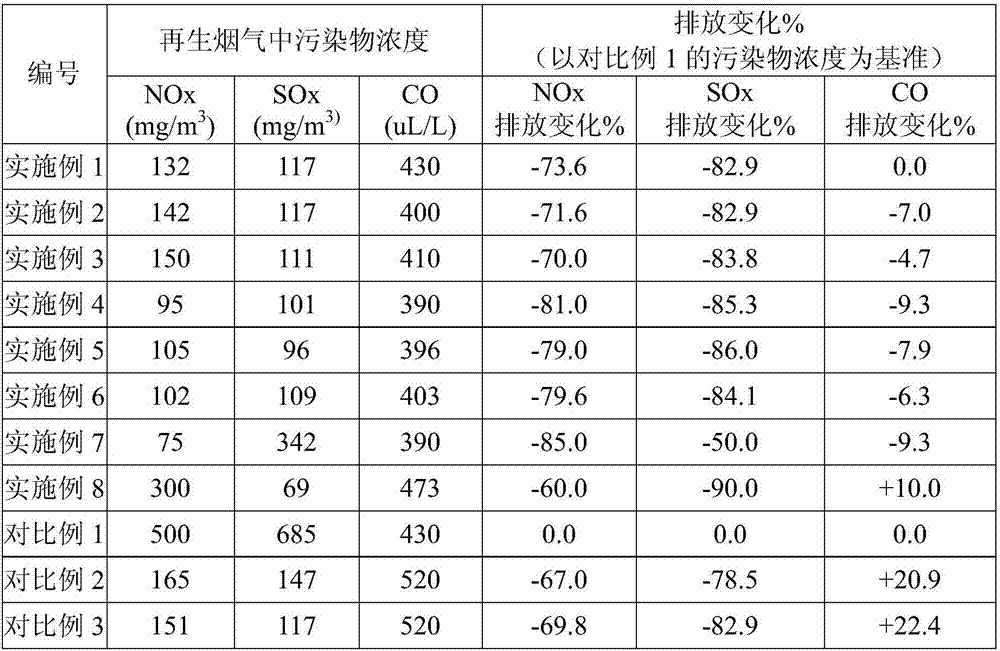Cocatalyst for reducing FCC (fluid catalytic cracking) regeneration flue gas pollutant discharge and application thereof
A pollutant emission and co-catalyst technology, applied in the direction of physical/chemical process catalysts, metal/metal oxide/metal hydroxide catalysts, heterogeneous catalyst chemical elements, etc., can solve the problem of not achieving efficient removal of SOx
- Summary
- Abstract
- Description
- Claims
- Application Information
AI Technical Summary
Problems solved by technology
Method used
Image
Examples
Embodiment 1
[0034] This embodiment provides a co-catalyst for reducing the emission of atmospheric pollutants such as NOx, SOx and CO in the regeneration flue gas. The co-catalyst includes microsphere particles A and microsphere particles B.
[0035] Wherein, microsphere particle A is prepared by the following steps:
[0036] Add deionized water into the stirring tank, then add 1.576 kg of pseudo-boehmite for beating, control the solid content of the slurry to about 12%, and beat for about 30 minutes; add hydrochloric acid solution, control the pH of the slurry to 1.2-2.0, and beat for about 60 minutes ;Continue to add 0.097 kg of kaolin into the stirring tank, beating for about 60 minutes; heat up to 60-80°C, let it stand for aging for about 120 minutes and continue stirring for 30 minutes, and then pump the colloidal material after beating into the spray drying system , to obtain a microsphere particle carrier, the microsphere particle carrier was calcined at 700° C. for 120 minutes to ...
Embodiment 2
[0045] This embodiment provides a co-catalyst for reducing the emission of atmospheric pollutants such as NOx, SOx and CO in the regeneration flue gas. The co-catalyst includes microsphere particles A and microsphere particles B.
[0046] Wherein, microsphere particle A is prepared by the following steps:
[0047] Add deionized water into the stirring tank, then add 1.665 kg of pseudo-boehmite for beating, control the solid content of the slurry to about 12%, and beat for about 30 minutes; add hydrochloric acid solution, control the pH of the slurry to 1.2-2.0, and beat for about 60 minutes ;Continue to add 0.002 kg of kaolin into the stirring tank, beating for about 60 minutes; heat up to 60-80°C, let it stand for aging for about 120 minutes and continue stirring for 30 minutes, and then pump the colloidal material after beating into the spray drying system , to obtain a microsphere particle carrier, the microsphere particle carrier was calcined at 700° C. for 120 minutes to ...
Embodiment 3
[0056] This embodiment provides a co-catalyst for reducing the emission of atmospheric pollutants such as NOx, SOx and CO in the regeneration flue gas. The co-catalyst includes microsphere particles A and microsphere particles B.
[0057] Wherein, microsphere particle A is prepared by the following steps:
[0058] Add deionized water into the stirred tank, then add 1.468 kg of pseudo-boehmite for beating, control the solid content of the slurry to about 12%, and beat for about 30 minutes; add hydrochloric acid solution, control the pH of the slurry to 1.2-2.0, and beat for about 60 minutes ;Continue to add 0.213 kg of kaolin into the stirring tank, beat for about 60 minutes; heat up to 60-80°C, let it stand for aging for about 120 minutes and continue to stir for 30 minutes, then pump the colloidal material after beating into the spray drying system , to obtain a microsphere particle carrier, the microsphere particle carrier was calcined at 700° C. for 120 minutes to obtain 1 ...
PUM
| Property | Measurement | Unit |
|---|---|---|
| Bulk density | aaaaa | aaaaa |
| Bulk density | aaaaa | aaaaa |
| Density | aaaaa | aaaaa |
Abstract
Description
Claims
Application Information
 Login to View More
Login to View More - R&D
- Intellectual Property
- Life Sciences
- Materials
- Tech Scout
- Unparalleled Data Quality
- Higher Quality Content
- 60% Fewer Hallucinations
Browse by: Latest US Patents, China's latest patents, Technical Efficacy Thesaurus, Application Domain, Technology Topic, Popular Technical Reports.
© 2025 PatSnap. All rights reserved.Legal|Privacy policy|Modern Slavery Act Transparency Statement|Sitemap|About US| Contact US: help@patsnap.com



